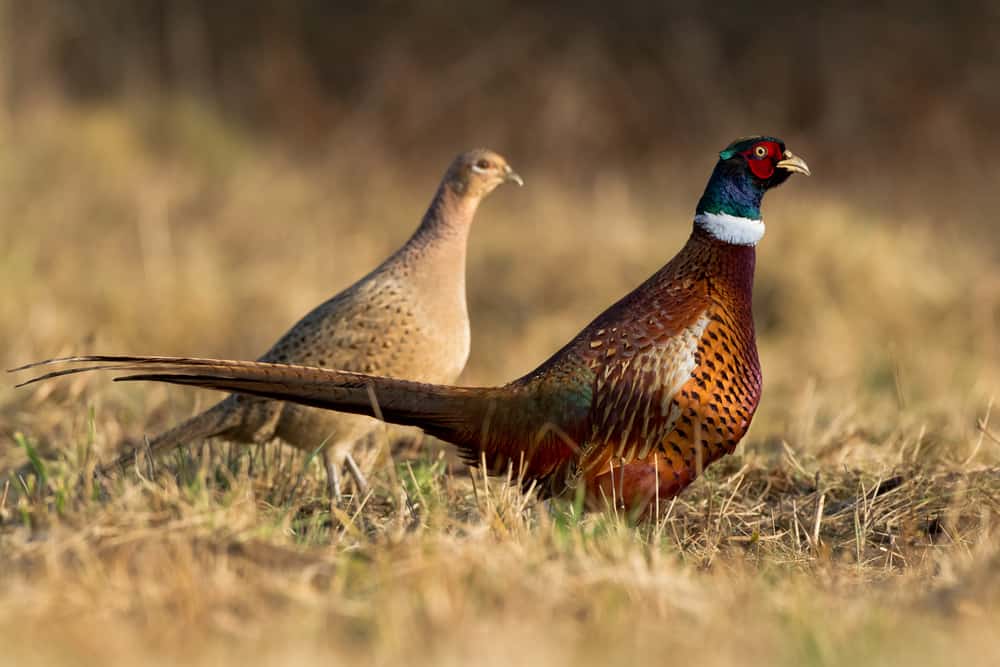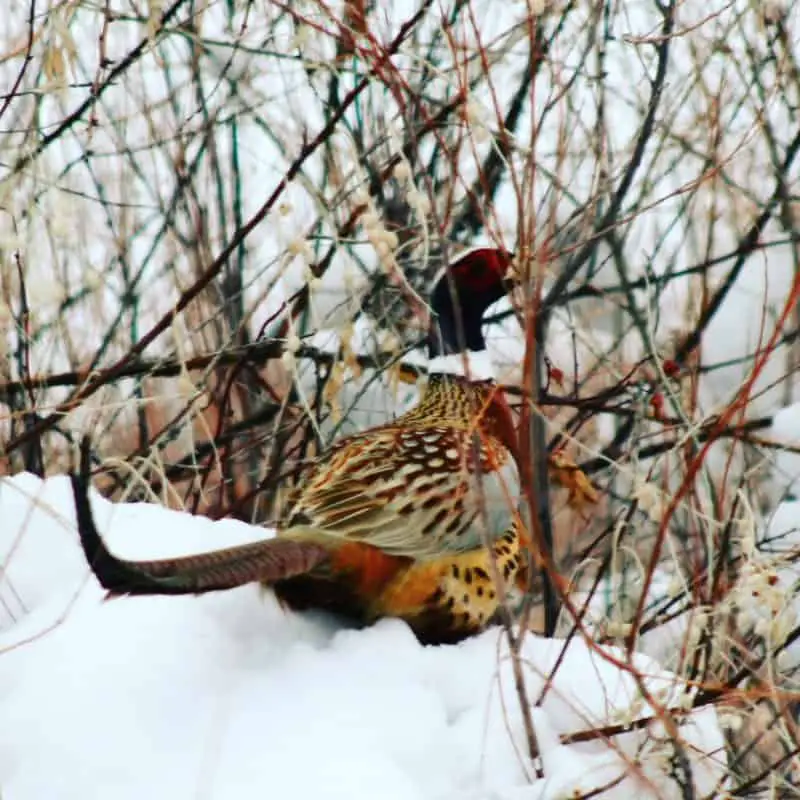Ring-Necked Pheasants are undoubtedly the most popular upland game birds in the United States. However, they aren’t even native to North America. They’re an introduced species from China.
The first pheasants to come to the United States were Black Necked Pheasants from game farms in England. They were imported to New York and New Jersey in 1773. However, these birds weren’t adapted to the environment, and they eventually died out. Source
The first ring-necked pheasants were introduced into Oregon in 1881 from China, by Owen Nickerson Denny, who was the United States consul general in Shanghai. Denny made subsequent shipments of ring-necks to Oregon in 1882 and 1884. This is where the ring-necked pheasants that are on the North American continent today originated from. These birds propagated themselves so successfully that the first pheasant season was held in Oregon in 1892. Source It was a resounding success in that hunters reportedly took 50,000 birds on opening day.
For a time, some people in the U.S referred to ring-necked pheasants as Denny’s pheasants in honor of the man who first introduced them here. That name didn’t stick, though, and today we simply call them ring-necked pheasants.

What do pheasants look like?
Virtually everybody has seen a pheasant or at least seen a picture of one. If you are in a group of people who have not, I’ll describe them here. A male pheasant is called a rooster or a cock. They are primarily brown chicken-sized birds, weighing an average of around 2 1/2 pounds (1.13 kg). The brown on their body is interspersed with black, green, grey, and purple. Their tail feathers are brown with black bars. Their tails are proportionately long (up to 2 feet in length) and taper from their widest point at their rump down to a pointed tip.
Their heads are black with purple and green hues. They also have a slight feathered crest and feather tufts behind each ear, along with bright red wattles above and below each eye. True to their namesake, they have a white ring around their black neck.
A pheasant’s legs are proportionately long and built for running.
Female pheasants are called hens. Hens are smaller than roosters, weighing in at about 2 pounds (.91 kg) on average. They also lack the flashy colors and the wattles that roosters have. Instead, they are tan mixed with mottled dark brown and white.
Their pointed tails are shorter than a rooster’s.
Where do pheasants live?
Today there are ring-necked pheasant populations in 38 U.S states and 7 Canadian provinces.
They like to hang out along the brushy edges of farm fields. Consequently, the areas with the highest concentration of agricultural activity have the highest concentration of pheasants.
The large industrial farms that we have today are less friendly to pheasants because there are fewer brushy fence rows and less marginal unused ground than there used to be. There are still more pheasants in farm country than elsewhere, though.
They also like areas along the edge of woodlands or swampland with a high density of tall grass and or cattails and brushy cover.
In the U.S, South Dakota is the state with the undisputedly highest concentration of pheasants. Pheasant hunters in South Dakota routinely take over 1 million birds per year. The pheasant is also South Dakota’s state bird.
As stated before, though, South Dakota isn’t the only U.S state with pheasants. They thrive wherever there’s a lot of farming going on.
Around the world, the Ring necked-pheasant in its various forms is indigenous to China, Mongolia, North and South Korea, Taiwan, Russia, Kazakhstan, Uzbekistan, Turkmenistan, Afghanistan, Georgia, Azerbaijan, and Armenia.
They have also been introduced to every continent on earth, except for Antarctica.
Pheasant behavior
How do pheasants escape from predators?
Pheasants fly very well for short distances, but their bodies are built for traveling swiftly along the ground. They can run up to 10 miles per hour(16 kph).
When these birds detect a perceived threat, they prefer to run along the ground. If the cover they are in isn’t sufficiently tall to completely conceal them, they’ll run in a crouched position with their neck stretched out parallel to the ground.
If given the opportunity and sufficient cover, they will at times circle behind oncoming hunters.
At other times they’ll crouch down as flat to the ground as they possibly can and let the hunter or other predator pass by without detecting them.
When all other remedies have failed, pheasants will fly from danger. They can explode from cover almost straight up. If it’s a rooster, he’ll often cackle with a cak cak cak cadence as he flushes off the ground. When pheasants are in a hurry, they can fly up to 60 miles per hour (97 kph)
Flying expends a great deal of energy for pheasants, so they usually only go far enough to put themselves out of reach from the perceived immediate threat. The average length for a pheasant flight is around 600 feet (183 meters), although the record length for an observed pheasant flight was made in 1941 when a pheasant was observed to fly 4 miles ( 6.44 km) in crossing a body of water. Source
How do pheasants mate?
Pheasants are sociable birds and may live in flocks through the winter months. However, in the early spring, rooster pheasants establish breeding territories. They patrol these areas, and the dominant rooster kicks the less dominant ones out of his domain.
At this time, it’s common to hear roosters crowing to warn off any intruders to their domain. It’s also common to see roosters fighting for dominance. They will approach each other posturing with their necks stretched forward and their heads bobbing up and down. They will then fly up into the air, pecking, and gouging at each other with the sharp spurs on the backs of their feet. This battle goes on until one of the combatants backs down.
The dominant rooster will breed with a harem of multiple hens.
After breeding season, roosters and hens go their separate ways. The hen takes care of all the nesting responsibilities and rears the chicks on her own.
Where do pheasants nest?
The nesting period for pheasants is anytime from April to June. Hen pheasants build their nests on the ground. They usually locate them in thick grass, but cattails, weeds, or some other type of thick cover will also suffice. Their nest will be a shallow, shallow scrape that they line with some of the surrounding vegetation.
They will lay 10 to twelve eggs to a clutch and incubate them for roughly 24 days. The chicks are ready to leave the nest within hours after hatching. They’ll follow their mother for the first 80 or so days of their lives, though, before they become fully independent. During this time in their lives, they mainly eat insects.
What do Pheasants eat?
Pheasants are omnivores. They do most of their foraging from the ground, but they fly up into a bush to feed on berries. On the ground, they feed on grass seeds, waste grain from farm fields, blades of grass, insects, worms, and pretty much anything along those lines.
Where do pheasants sleep?
They will do one of two things. They generally bed down in some dense cover such as tall grass sometimes, though they’ll roost on a tree branch to get away from any nocturnal predators.
Final thoughts
Ring-necked pheasants are the most popular upland game bird in America for multiple reasons. The heart-stopping way they burst from cover with a chorus of loud cackles and a whirring of wings, their colorful plumage, and the fact that they’re very good eating are just some of them.
Be sure to remember and pay tribute to a man named Owen Denny the next time see one.
Also see: Sage Grouse – Krebs creek
Chukar Partridge – Krebs Creek
Facts About Ptarmigan – Krebs Creek
Recent Posts
The only venomous snakes in Washington State are Northern Pacific Rattlesnakes. The Northern Pacific Rattlesnake (Crotalus oreganus oreganus) is a sub-species of the Western Rattlesnake. Anyone...
Skunks are not classified as true hibernators. But they go into a state of torpor when the weather gets cold. Skunks are light sleep hibernators, along with opossums, bears, and raccoons. ...

